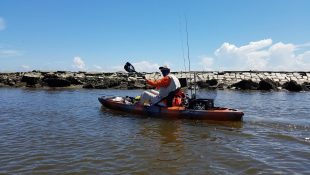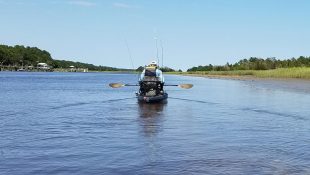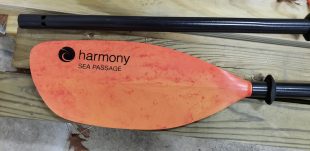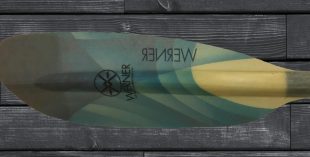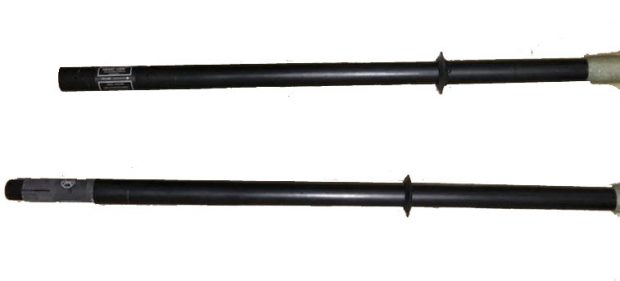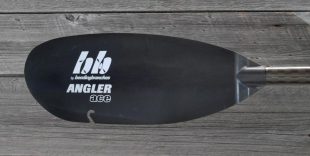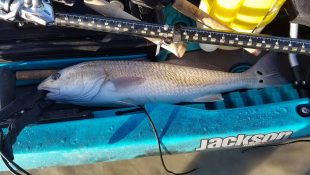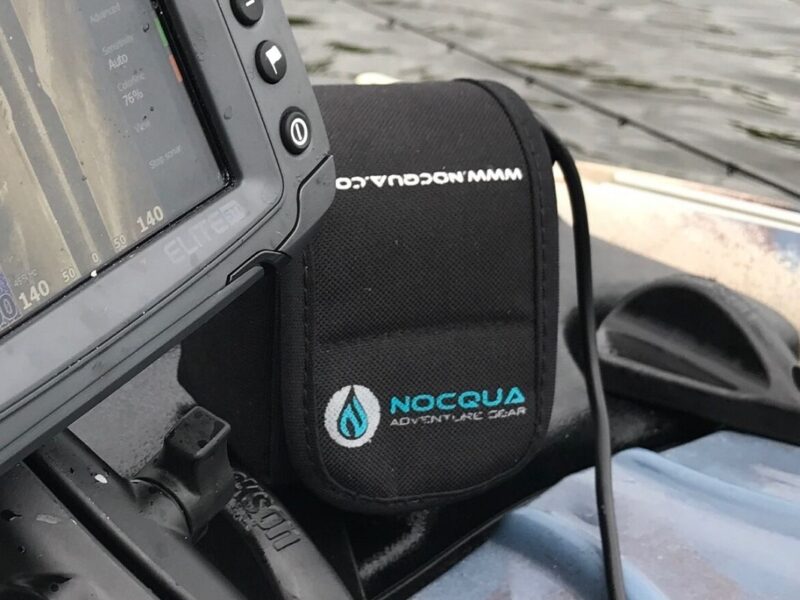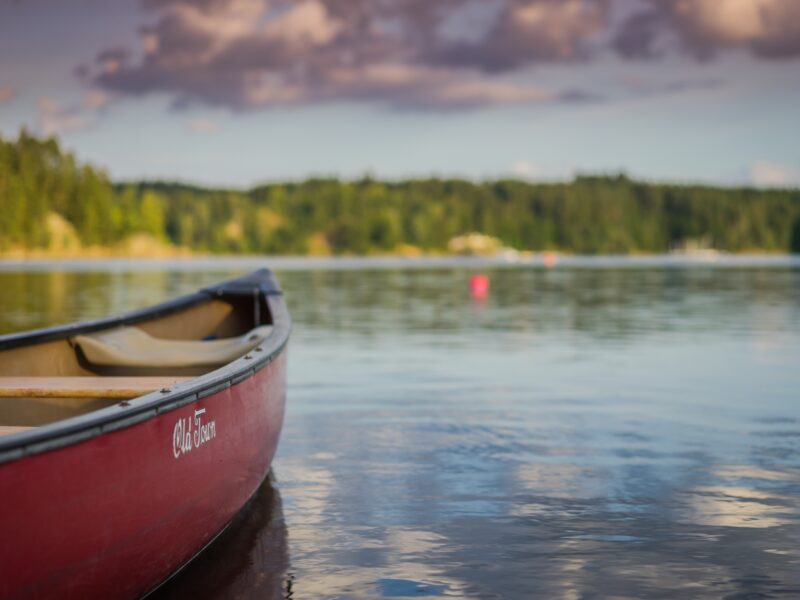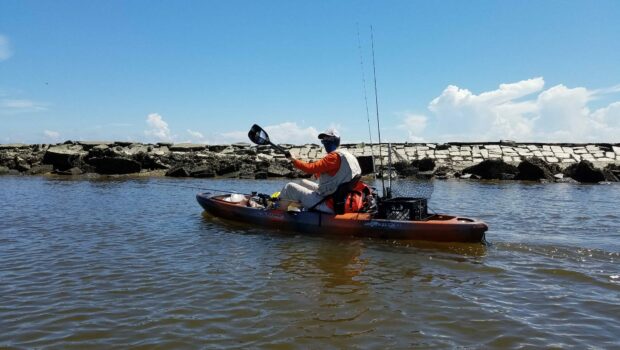
How to Choose a Kayak Paddle for Fishing
What should you look for when buying a kayak paddle? You will need to do a lot of research, but your main focus should be on choosing the paddle angle, shaft material, blade material, paddle weight, paddle length and paddle features that best suit the type of paddling and type of kayaking you will be doing.
Paddle design has come a long way since the days of heavy hand-carved wood. Learn everything you can from this article and get yourself a wicked good paddle as a part of your kayaking fishing checklist, and have an excellent trip out on the water!
Quick Links
- What Paddle Length Should I Get?
- Paddling Style – High Angle vs Low Angle
- Choosing a Paddle Blade – Shape and Material
- What is Paddle Shaft Ferrule and Feathering?
- Paddle Swing Weight
- Fishing Features
What Paddle Length Should I Get?
What is the right paddle length for me? That is the most common question when you first start kayaking and it can be quite overwhelming. If you choose a paddle that is too short you’ll either bang your knuckles on the side of the boat or have to lean out of the kayak for a clean stroke. If you get a paddle that is too long then you’ll be putting extra strain on your shoulders and you’ll zig zag through the water. Paddle choice is a big decision, make sure it pairs well with your kayak.
Simply put, choosing the correct paddle length relies on three things:
1. Paddler Height
2. Width of the Kayak
3. Paddling Style
Plug your height and your kayak width into the chart below to find the recommended paddle size. If you plan on using a low angle paddle then add 10 cm to the recommended paddle size. Also add 10 cm if your kayak is substantially wider than 32” or utilizes an extra high seat.
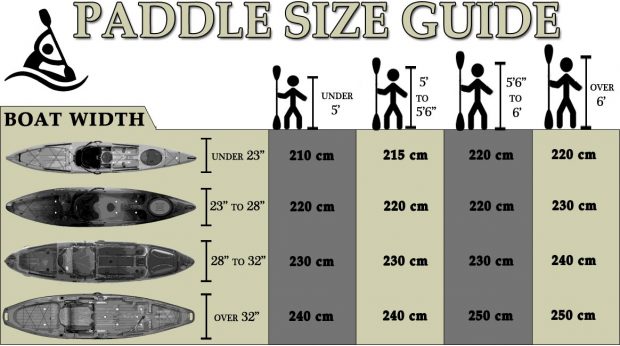
My Paddle Specs
Personally I am 5’10”, my primary kayak is a Jackson Coosa which is 32” wide, and I prefer a high angle paddling style since I fish often around docks and want to quickly reposition the kayak with a powerful stroke. Based on the chart I am firmly in the 230 cm category for paddle length. I bought a Bending Branches Angler Ace and it has been a perfect fit for me. I also have used all of the top paddles here as well.
Telescoping Paddles
A relatively new technology introduced into the paddle market are paddles with an adjustable shaft length which lets you change your paddle length on the fly within about 20 cm – perfect for kayaks that utilize high and low seating positions! This also is excellent if someone else is using your paddle or you’re switching between different kayaks.
Paddling Style – High Angle vs Low Angle
Kayak paddles are designed with either a high or low angle paddling style as the primary use. A low angle blade will have less surface area and will be thinner and more drawn out. A high angle blade has more surface area and will be taller and shorter.
Paddling style varies greatly depending on what type of activity or water you’re focused on. Low angle paddling is perfect for sea kayaking long distances, open water lakes and rivers, and leisurely touring. It allows you to paddle further with less fatigue. High angle paddling is best suited for whitewater kayaking, fast flowing river kayaking, or paddling where you want to make big fast adjustments.
High Angle
High Angle Paddling is a more aggressive and powerful stroke that comes into the water from a higher or more vertical angle with the paddle blade. More of the blade is in the water which generates more resistance and more power in a single stroke
Low Angle
Low Angle Paddling utilizes a more relaxed stroke meant for long distance touring. The paddle blade enters the water at a lower angle, or more horizontally so less of the paddle is in the water which provides less resistance in each stroke.
Choosing a Paddle Blade – Shape and Material
Blade Shape
When choosing a paddle blade shape the main contributing factor is your paddling style. If you determined above that you are a high angle paddler then you will want to get a paddle that has a shorter and wider blade with more surface area to push more water and generate a more powerful stroke. If you determined that you are a low angle paddler then you will want to focus on a paddle that has a longer and thinner blade with less surface area for a more efficient and relaxed stroke.
Blade Material
Kayak paddle blades are primarily made from three materials – fiberglass, carbon fiber, or plastic. There are variations and blending of these materials, but this is what it boils down to. Each has pros and cons but what you’ll want to look at is durability, stiffness, price, and weight and apply that to your budget and paddling environment.
| Material | Durability | Stiffness | Weight | Price |
|---|---|---|---|---|
| Plastic | Prone to cracks and sun damage | Some flex in water | Heaviest | $ |
| Fiberglass | Can chip, won't crack | Quite stiff - great choice | Average | $$ |
| Carbon Fiber | Very durable | Ultra stiff - best choice | Lightest | $$$ |
Paddle Shaft – Ferrule, Feathering, and Material
Shaft Materials and Construction
Paddle shaft makes up the bulk of the paddle weight. Common materials typically include aluminum, fiberglass, and carbon fiber. Each of these three materials have an inverse price to weight relationship, meaning the lower the weight the higher the price.
- Aluminum is typically a material for entry level paddles. It is strong but a good bit heavier than other materials and the shaft temperature can fluctuate quite a bit.
- Fiberglass and carbon fiber are good choices for kayak paddle shafts since they are stiff, strong, and lightweight.
A paddle can also have a straight shaft or a bent shaft. A bent shaft paddle is similar to a curl bar when it has ergonomic bends in the handle that put your hands and elbows at a better angle for paddling. These are much more popular for whitewater kayaking than for recreational and fishing kayak outings. I personally prefer a straight shaft paddle.
Feathering
The shaft construction can be one piece, two pieces, or four pieces. Four pieces is purely for portability – like if you are traveling and have space constraints. A one piece paddle will be a good choice for maximum energy transfer and strength, with the one caveat being that you have to paddle with matched blades. A two piece paddle is by far the most common and allows you to choose between matched or feathered blade alignments.
- Matched blade alignment – The two blades of your kayak paddle mirror each other and are on the same plane.
- Feathered blade alignment – The blades of the paddle are offset from each other anywhere from 15 – 45 degrees to reduce wind resistance when your paddle is out of the water.
Ferrule
Does anyone truly know what ferrule means? I definitely did not, I had to look it up. A ferrule system is the piece that connects the parts of a kayak paddle together. Don’t know why that’s not called an attachment point, sleeve, joint, connector? But ferrule it is.
Paddle Swing Weight
This seems like a very trivial marker on a paddle when we’re just talking about a few ounces difference. However I can guarantee you that it does make a difference. If you have the opportunity paddle around for an hour with a basic heavy paddle, then switch over to a carbon fiber lightweight paddle. The difference is just insane. Also look at the math:
- 37 ounces for a basic paddle vs 23 ounces for a high end paddle = 14 ounces extra per stroke
- If you’re out fishing I’d estimate you’re paddling somewhere around 3 miles (estimate 500 strokes per mile)
- 11 (ounces) x 500 (strokes) x 3 (miles) = 21000 ounces = 1312 extra lbs of swing weight
That’s a lot of extra weight! And yes, I guarantee you will feel it the next day.
Fishing Paddle Features
Kayak paddles designed for fishing often have a few extra features that can really come in handy. You’ll see hook retrievers built into the blade, tape measures printed on the shaft, and special grips and graphics.
The best kayak fishing paddle depends on what type of kayak fishing you do most often. I prefer to use a larger stiff blade and a high angle stroke because I often fish around bridges, cover, and other areas that require a powerful paddle stroke to quickly adjust my position. However if I went offshore in my kayak I would hands down switch to a low angle paddle since that would require paddling long distances.
Overall, use the information you’ve gained and focus on what type of fishing you’re doing – then you’ll be able to choose the best paddle for you.
Check out our other articles about Kayak Fishing:
- HOW TO FIND KAYAK FISHING SPOTS
- KAYAK FISHING CLOTHES – A GUIDE ON WHAT TO WEAR
- BEST LIFE JACKETS FOR KAYAK FISHING
- HOW TO CHOOSE A KAYAK TROLLING MOTOR BATTERY
- THE BEST STAKEOUT POLES FOR YOUR KAYAK, SUP, OR CANOE
- A GUIDE TO THE BEST KAYAK AND CANOE CARTS
- TOP 5 KAYAK FISHING PADDLES OF 2021
- BUYING A USED FISHING KAYAK: 10 YEARS OF EXPERIENCE
- BEST FISHING KAYAKS
- YOUR KAYAK FISHING GEAR CHECKLIST
- KAYAK FISHING WITH GATORS
Heath Anderson
Heath lives in North Carolina and has been an avid fisherman and all around outdoorsman for the past three decades. In addition to enjoying the outdoors, Heath has been active in the online fishing industry since 2010, teaching and sharing reviews of fishing products on BassGrab.com to help anglers catch more and look good while doing it.
All stories by: Heath Anderson


